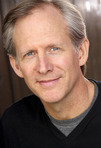Ian Bull's Blog, page 6
July 11, 2013
Dark California : Easy Access to Crime Part 2 : On my street
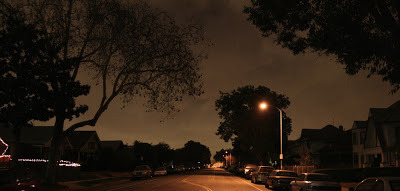
Last week I wrote about crime and suspicious activity on my street -- not just my neighborhood, but also my actual suburban Los Angeles block. I like to build to the good stuff, so this is the second blog post of three that are coming. Last week I mentioned the crimes of commuters speeding during rush hour, failed actors abandoning their cars, and the exchange of stolen property (electronics, luxury cars and weapons), which happens across the street on the corner. This week, let’s discuss home invasion, drug deals, and stabbings, all of which have happened on my block as well! The first type of crime occurs in the middle of the day. Because I work in TV, I have odd hours, odd jobs, and sometimes no job, which means I am often home between 11 and 2. Here is what I’ve witnessed:
The Casual Home Invasion I am home alone, writing, and I hear someone trying my doorknob. I go to the front door and I ask “who is it?” and I hear no answer. I look out the window and see that the person who tried to open my door has already left and is proceeding to my neighbor’s home. He’s average in every way, but he also is wearing an orange vest, the kind that street workers use, but also the same kind you can buy at the hardware store for twelve dollars. I step outside to track his actions, but if he’s aware of me comma he’s smart enough not to look in my direction. He has a clear strategy. He walks with authority and confidence up to every door on the block, one after the other, and tries the door to see if it’s open. If it’s not, he just keeps going. When I call the police they tell me they haven’t caught him yet, but this crime is common and profitable. 1 out of 50 homes is unlocked, he can easily try 50 doors in a little over an hour, and he’s sure to find a home to invade and rob soon.
The Violent Home Invasion The violent home invasion involves the mule kick, and for this crime the perps usually arrive in pairs. Two guys approach the house, and one rings the doorbell and knocks on the door while the other checks the driveway and the side of the house. If someone comes to the door, they make loud noises and shout, scaring whoever is inside -- the last thing they want is for the homeowner to open the door and see and identify them. They say things like, “Hey, we got a live one! I don’t like this! No way! Wrong house! This isn’t Jim’s place!” They are loud and scary, but the comments are general and not legally “threatening,” but the homeowner hears them and stays inside. But if no one answers, one will turn his back, brace himself and mule kick the door, which rips the door through both the frame and the locks. They grab what they can in less than a minute, and they go. This hasn’t happened to me, but it’s happened on my block. Evening crime:
The Drug Deal I live one block off a major boulevard and there is a narrow alley between the boulevard and my block. The residents of the apartment buildings on the boulevard use the alley to drive into their ground floor parking lots, and on the residential side, the owners store their garbage cans and have access to their own detached garages on the alley. At night the alley is dark, with only the light from the gas station on the corner illuminating the narrow strip of asphalt. If you drive down this alley after 11 p.m., cars will be parked there; lights on, engine running, and the men are doing business. They will not let you pass and they will motion for you to go around. If you insist you’d like to drive by, someone comes close and tells you to turn around.
Stabbings I should make this singular, because there was only one stabbing, but it was directly in front of my house and on the opposite side of the street. The crime was simple: A drug buyer approached a drug dealer in the alley, somehow got the drugs in his hand before handing over the money -- and he ran. The dealers pursued him down the alley on foot. He cleared the corner, turned right and tried to go deeper into the neighborhood to elude his pursuers, but made a right again on our block. This, unfortunately for him, is where the dealers caught up. There were no gunshots --- they just stabbed him three times, a car roared up, the dealers jumped in and drove away. Bleeding badly, the drug buyer banged on doors, but no one opened up for him at 1 in the morning. Knowing he needed an ambulance, he then ran two blocks to the main boulevard. Where he ran into traffic and risked getting run over -- but someone stopped and called 911 and the ambulances came. He survived. The next morning all the neighbors seemed to instantly know about the stabbing, as if we all learned it through atmospheric osmosis. We crossed the street and looked at the red stain on the sidewalk where the victim had lost several pints of blood, and it looked like spilled wine. The sprinklers came on and washed it away. We compared the details we heard and we talked about how we need to put lights in the alley. A police cruiser turned the corner and came by, and the two officers on patrol drove by slowly. We all waved nervously, they waved and nodded back. They were just keeping tabs on the street where the bad stuff went down the previous night. They kept rolling. The crime has come and gone, but we felt better, for some reason. Still, what creates the most stress is knowing how random it all is. Like a tornado that touches down in the Midwest and destroys some homes while ignoring others, crime works the same way in Los Angeles.I want your feedback!Is your neighborhood like mine?Or is Los Angeles unique? Do you feel that crime is random no matter where it is, or is there a pattern than can be gleaned through observation -- and therefore prevented?I want to know about crime where you are, what we can learn from its patterns and how we can stop it.
Next week -- San Fernando Valley Pornography -- filmed right on my block. It’s as much as story about a dropping economy as dropping clothes, so please read!
Published on July 11, 2013 18:58
July 4, 2013
Dark California: Easy Access to Crime - Part 1
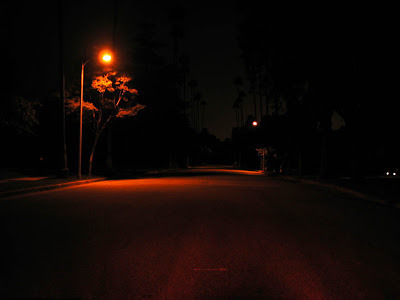
I live on a street that’s perfect for random Los Angeles crime. In LA, the flow of traffic determines our decisions. If we can get somewhere easily, park easily, and leave easily, we choose that route and that destination over others. Whether it’s a job, a store, a restaurant, or a school - if it’s easy for us to get there, that matters as much as cost or quality. Lost time in traffic is just too frustrating.
The same logic applies to crime as well, and unfortunately for me and my family, we live on a street where the flow of traffic makes random crime easy. I live in a wonderful neighborhood with nice front lawns and white picket fences. My street is also one residential street away from two major surface streets, and we are the first residential street you find when you exit the freeway and head south.
Two right hand turns, park the car, do your nefarious business, and you can zoom back down the street and get back on the freeway in less than two minutes. One or two blocks deeper into the neighborhood, and that ease disappears. Like random molecules in space, moving blood vessels, or water in a stream, traffic follows the easiest route, and thus so does all the trafficking in which humans engage.
Crime in Los Angeles only seems random. Whether it’s road rage or robbery, it flares up suddenly and then disappears, and we all wonder, “why did it happen here?” Looking closer, I believe that the seeming randomness of the crime can be explained by how traffic made that crime convenient to commit.
In increasing order of magnitude, here are the crimes that occur in front of my home every year:
Aggressive Speeding
I live one block from a major North/South artery, and one block from a major East/West artery, and the flow of traffic backs up on both the morning and evening rush hours. Drivers sit in their cars in bumper to bumper traffic, watching the traffic lights at that major intersection change again and again, yet they never move forward.
Until their frustration builds and they finally reach our block first. Why wait another ten minutes to go one block? They make a turn, zip down our street and make a quick right hand turn and they’re heading where they want to go that much faster.
That’s not a crime. However, when they reach our street their frustration is released -- and they punch that gas pedal and go from fifteen to fifty miles per hour, gritting their teeth to hold in their road rage.
Crossing the street or backing out of our driveway is tough when you’re up against the Road Warrior.
Abandoned Cars
People get tired of life in Los Angeles, and they need to get away. Sometimes they need a vacation, sometimes they need to leave the country for a few months, or go home to Tennessee to stay with their parents for awhile. Sometimes they’ve given up on Tinseltown and they drop everything and go. Sometimes people steal cars and they just need to leave them somewhere.
I’ve seen all of the above happen, and they all leave their cars for me to monitor.
More than once I have seen people drive up, park their car in front of my home, get out and lock their cars, and another car zips up to pick them up, and they disappear. And that car stays there for days, weeks, and then months.
Each car has a story, and if the car is there long enough for a spider to weave a cobweb on one of the tires, I start poking around and peering in the windows.
They sometimes have school parking permits hanging from the rear view mirrors, or out of state license plates, or a pile of actor head shots on the back seat. Sometimes the back window is shattered, or the trunk has been pried open then tied shut with twine.
Once I called a phone number I saw at the top of head shot, and another time I called the sheriff in a small county in Tennessee -- but no one appreciated my amateur sleuthing. “It’s not illegal to park my car there!”
Actually, it is. It’s called abandonment, and now I just call the City to tow it away.
The Exchange
“The Exchange” is more dramatic and happens several times a year. My block is easy to find from the freeway, it’s easy to get back on the freeway yet again, it’s quiet and there’s usually plenty of parking. This means that it’s a perfect spot for a quick exchange of illegal goods.
I’ve seen two cars turn the corner and roar up -- one is expensive and usually without plates. Leaving the motors running, men get out of both cars and stand there looking tough while two of them exchange cash.
I am playing in the front yard with my daughter, dancing on our lawn surrounded by a white picket fence, and I stop playing to look at them. They see me watching and they stare back at me, and their message is clear -- “What are you looking at?”
If I keep looking they will take a step forward, and if I look away, they will leave...so I look away. They complete their transaction, the cars are exchanged and roar away.
Other times I see trunks open and the men move items from one trunk to another. Sometimes they move boxes of electronics, and sometimes they move long sturdy objects wrapped in burlap or oil cloth.
The men glance at me again, questioning why I am watching, and again I look away. Cash is exchanged, the transaction is completed, and they leave as well.
I then go back to playing with my daughter and drift back into our version of suburban bliss.
Over the hiss of the sprinklers, however, there is a high-pitched hiss that never goes away -- the sound of the freeway half a mile away, with a noise so continuous that you never notice it unless you someone points it out to you, or you notice its stunning absence on certain holiday mornings when the freeway is empty.
That’s our urban river, and these random men finish their business and flow back into the stream of cars and disappear.
Next week, we’ll continue with drug deals, stabbings, and home invasions.
Published on July 04, 2013 18:37
June 27, 2013
Hidden California : The Temple to Guan Gong
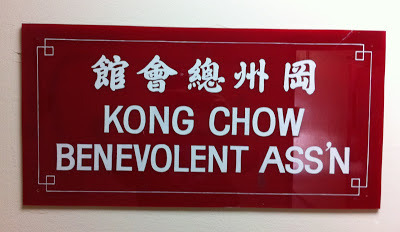
On Stockton Street in San Francisco, in the heart of Chinatown, on the third floor of the Kong Chow Benevolent Association building, you will find the temple to Guan Gong. It’s a plain beige stucco office building with a few shops on the bottom floor, and with offices on the upper floors perfect for accountants and dentists to hang their shingles. There’s a narrow black Otis elevator in the back, and tacked to the wall is a faded piece of paper with Chinese writing with a tiny scrawl in English at the top -- Temple, Third Floor.
You ride up three floors, step out into an entranceway filled with shopping bags and suitcases, then step through a beaded curtain and into an sun-filled atrium in which sits a massive statue of a stern and red-faced warrior with a long beard, who carries a long pole with a blade -- General Guan Yu, most often called Guan Gong, or Lord Guan. Surrounded by urns filled with burning incense, smaller statues of minor deities and stacks of fruit offerings and flower bouquets, Lord Guan’s wooden face glowers at you, tolerating your presence, as if asking you to speak quickly and explain why you’ve come.
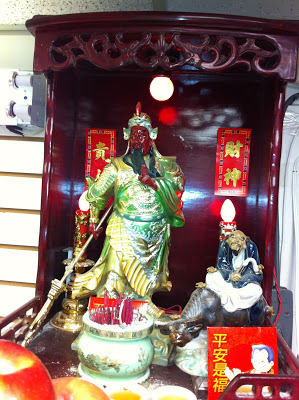
He is the patron saint to many residents in San Francisco’s Chinatown, and you will spot a shrine to him in the back corner of many shops. He is the patron saint to warriors, to police officers, to criminals, to poets, to artists and to travelers - in other words, people who feel they must live apart from the rest of society, and therefore follow a separate code. Since many residents of Chinatown still see themselves as travelers to our country, removed by fate or choice to live apart from the great Middle Kingdom, Guan Gong is the deity who watches over them.
I first learned about Guan Gong as a kid when I watched the play F.O.B. (which stands for Fresh Off the Boat), written by David Henry Hwang, in which Guan Gong comes to life in a seedy Chinatown restaurant. I was then introduced to the temple as a teenager, when I was doing documentary photography and I wanted an introduction to Chinatown. My oldest childhood friend, Kelvin Han Yee is an actor who is well-known in San Francisco, but at the time his father, Kong Yee was even better known in Chinatown, and he was my guide to places I’d never have found otherwise.
Kong Yee was the Clerk of the Court for the City and County of San Francisco for many years, specifically, Night Court. And in that court, the most pervasive crimes that were addressed night after night for years on end were -- parking tickets. And where is the parking worst in the city of San Francisco? Chinatown.
The merchants and delivery trucks working those narrow steep streets gather dozens of parking tickets a month as a normal price of doing business, but if you remain a scofflaw for too long, your car or truck will be towed or its registration denied, and you end up in Night Court.
For years, Cantonese-speaking Clerk of the Court Kong Yee was the liaison between the judges and the scofflaws, and he’d help broker the deals between the two. The City would get some of its money, and the merchants would get to keep running their businesses in a neighborhood vital to tourism. This meant that when Kong walked through Chinatown, he had juice. People would come out in the street, shake his hand, press a gift on him, beg him to come in for some food, thank him for fixing a problem or beg him to address a new one.
When I was with Kong, I was a caucasian kid who wasn’t merely tolerated but I was welcomed, and he showed me back kitchens and garment factories and gambling parlors I wouldn’t have seen otherwise -- including the temple to Guan Gong.
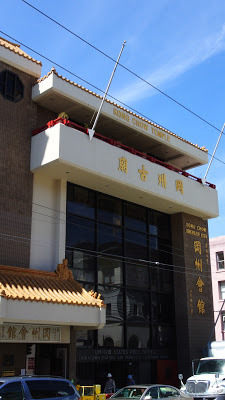
Once you enter the temple there is no rush to help you. An old Chinese granddad wanders up to you, the same kind of guy in the padded coat with a bag of groceries who you see riding the 30 Stockton bus, and it turns out he is the Taoist priest who runs the place. He knows why you’ve come, so there are no questions. He steers you to the wall where newspaper articles show the politicians who have come to pay their respects to Lord Guan in the past -- President Eisenhower, Governor Pete Wilson, and Mayor Willie Brown to name a few. The priest explains that if you want to win re-election, the politicians know you must visit Guan Gong.
You then pay five bucks, burn incense in ten spots around the temple, get on your knees and bow. Then, if you want, you can get your fortune told. You shake a bamboo container full of a hundred thin bamboo sticks with numbers on them, and whichever stick emerges as you gently shake is Lord Guan’s declaration of your future.
I went there recently with two good friends from my youth and from Cal Berkeley -- fellow writers and seekers Kevin Kirkpatrick and Douglas Gorney, who I knew would feel the same kinship that I have with Lord Guan.
The rituals were exciting, but when it came time to divine our futures, the fortunes we shook free indicated that Lord Guan had some stern and direct advice for us. The sticks warned one of us not to cut corners at work, he warned another that he must find and new place to live, and another was told there was no easy answer to his family health problems. These were not fortune cookie platitudes, and it didn’t seem like paying more money would have gotten us nicer outcomes.
“Work hard and then come back in December and see what he says then,” the priest told us all. I tried to take a photo, but he said no -- I didn’t have Kong with me to smooth things out this time.
We left the temple feeling energized and a little scared, and headed back to Grant Avenue. Before meeting my wife and daughter, we vowed to downplay the seriousness of what we’d been told.
If you want to read more about Lord Guan, go to:
wikipedia.org/wiki/Guan_Yu
Published on June 27, 2013 17:32
June 20, 2013
The Bell
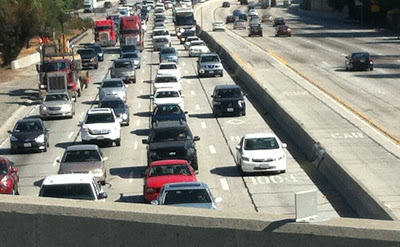
For the month of May 2013, I commuted from Studio City in the San Fernando Valley to West Los Angeles, close to the Santa Monica Border. It’s a trip of just 16 miles, and it took me an hour.
For the first 40 minutes of my commute, I only go 8 miles, which means I’m traveling at an average of 5 miles an hour, bumper to bumper, west on the 101 freeway and then south on the 405 freeway.
Then everything stops as I try to merge from the 101 West to the 405 South.
And that’s when I see it. Every morning I pass a solitary bell, rusted brown on a green pole shaped like a shepherd’s staff, cemented in the narrow strip of dirt between the freeway and the on-ramp.
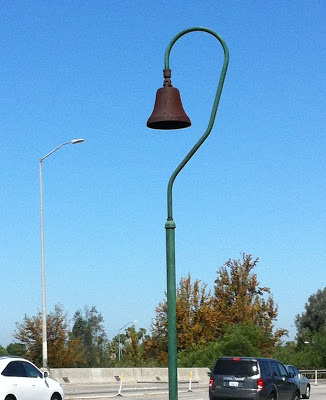
You catch glimpses of these bells along freeways everywhere in California, and they are there to remind you that you are supposedly driving along a route that was once the romantic and historic El Camino Real, the King’s Highway, the same road that the Franciscan Padres and Friars walked as they established the bucolic missions that later became the towns and cities of the picturesque Golden State.
As I pass this bell, inch by inch, I can’t help thinking that it’s for us, the poor saps stuck in traffic, taunting us on our morning commute.
Who else could it be for? You can’t see this sad, rusted bell if you are driving the speed limit, because it just flashes by. The only time it actually catches your eye is when you are stuck staring at it, stationary in your car.
In 2013, the bell no longer evokes any romantic notion of California’s past. Did it ever?
Maybe in 1955, driving along a new stretch of the 101 freeway, someone would look out their car window on their Sunday drive, coasting along and say, “Hey, look, there’s a bell marking El Camino Road! This new highway follows exactly the same path that the missionaries took when they walked north from mission to mission! This ribbon of asphalt which we coast along, reminds of the loam of the earth beneath it, where brave Californians before me once walked!”
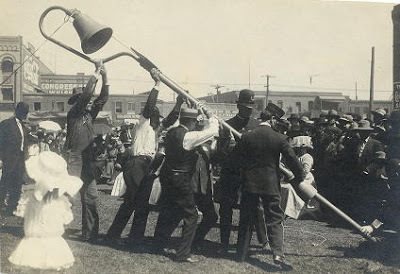
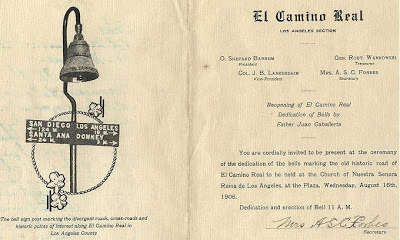 click to enlarge
click to enlargeThat may be what the original boosters who put in these bells hoped I would think when I see it, but this bell is now an unintended ironic joke on me and every other driver out there who idles past it every morning. The romance is gone.
When you grow up in California and go to public school, in fourth grade you do your “mission project.” There are 21 missions in California -- Mission Santa Barbara, Mission San Jose, Mission San Rafael, etc., - and there were also two pueblos (one is Los Angeles) and four presidios. Even with overcrowding in California schools, that means each kid in class is still assigned a mission to research and investigate. He or she then writes a paper and builds a paper mache diorama, and maybe even visits the actual mission with his or her parents on a weekend trip. Millions of school kids in California have done this for decades.
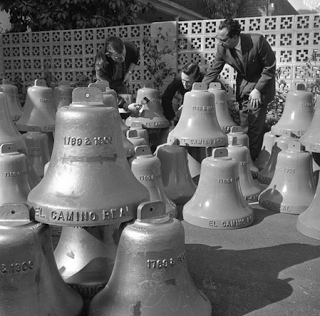
“Are we there yet?” a kid might ask on his family driving trip to his mission.
“I don’t know, we are getting close,” a parent might reply. “Look for the bells, after all, we are on the El Camino Real.”
In between San Jose and San Francisco, and in between many towns, the El Camino Real is an actual boulevard, and you can drive it for miles from town to town, but in Los Angeles the El Camino Real is the freeway. A blazing hot, noisy freeway with fumes and trash by the side of the road.
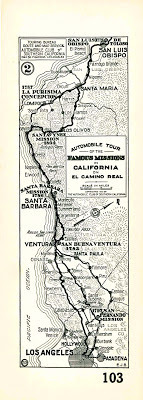 click to enlarge
click to enlargeI remember the romantic stories from school of conquistadors like Anza and Portola moving north through this Western paradise and blazing their way farther north, followed later by the Franciscan brothers who would walk the 26 miles between each mission in a day. They would then rest a day at a mission, and then walk again the next day, and thus a brother could walk the entire length of El Norte California in two months.
When they walked the El Camino Real they would carry bags of mustard seeds that they tossed by the handful, so that the next year the bright yellow flowers of the mustard plant would mark the way they had traveled the year before.
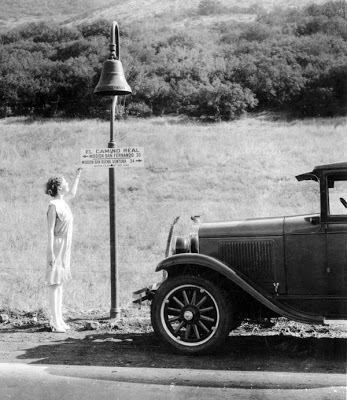
Of course, most of this romantic story is bullshit, just like the romantic myth of the Pilgrims and the Native Americans at the first Thanksgiving. We have evidence that the settlers at Jamestown, Virginia resorted to cannibalism to survive the first winters there, and there’s plenty of evidence that early California was just as brutal, and the true purpose of the missions was to secure political power.
I was taught that the missions were idyllic paradises where the natives learned agriculture and the crafts of civilization while the brothers tamed the wilderness. However, there are no native tribes left to confirm any of this. It may have been closer to enforced slave labor that became genocide.
Hey, Mom and Dad! There’s another bell! We’re almost to the mission!
So the bell celebrates a romantic myth of a past that wasn’t ever real, and I stare at it questioning the truth, but I also know that although it was brutal, the California they are trying to evoke was at least pristine for a time.
And California becomes less pristine every day, and as I sit staring at the bell as I idle in my car, I think of the climate change my carbon exhaust is exacerbating. There is:
A little less rainfall every year,
A little less snowfall,A little less snowpack,
A little less snow melt and runoff,
A little less water in the rivers,
A little less water for plants and animals and crops and people,
A little less water for electricity,
A little higher cost to buy the energy from out of state, but Washington State has the same problems,
Or we have a flood year where we get all our water at once -- but it doesn’t stay long because it melts too fast,
Which means more erosion and mudslides because there are fewer plants to hold the soil against the flash floods.
Which means when it dries out, the fires will come, like they do every year now, burning away even more growth to expose even more soil that can be washed away next year.
So while Oklahoma suffers from killer tornadoes, and the East Coast suffers from hurricanes that rip through cities and neighborhoods, and while the northern states endure brutal winter storms and spring months with record snow fall...
...California slowly heats up. Like me, moving in traffic at five miles an hour, the weather and climate in California changes gradually. Day by day we are becoming more of a desert, baking in the hot sun, tranquil -- until a brutal fire breaks out and destroys homes and forests and kills firefighters.
That’s what I think about when I’m stuck in traffic and I stare up this misplaced and misguided bell.
Maybe that’s its new purpose -- if it no longer can remind us of a California that never was, perhaps its point is to urge us to take notice of our slow, fiery decline so we can try to do something about it.
My job ends in eight days, and I am staying off the freeway. I won’t take a job unless it’s closer than fives miles away from home on surface streets.
For more information on these bells, check out:
cahighways.org/elcamino.html
Fore more on climate change :
climatechange.ca.govnewsroom.ucla.edu
Published on June 20, 2013 14:20
June 13, 2013
I am Walter Mitty
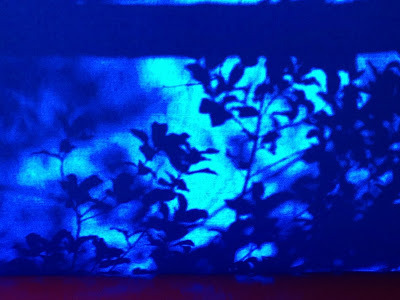
I am Walter Mitty. I make up stories in my head about former Army Rangers who can keep their cool in a fist fight and who know how to handle a weapon. I have met some of these people and I’ve felt their icy gaze as I peppered them with questions, but I am not one of them. The truth is, I haven’t been in a fist fight since I was thirteen. I also love to read about daring computer experts, hackers from Anonymous who stop evil politicians from rigging electronic voting machines, and CIA whiz kids who can ruin foreign nuclear centrifuges from afar, but I am not one of them either. To be honest, I can’t even program my own watering system. I stare at the keypad with Option A and Option B with variable start, stop and run times, and like a suburban Sisyphus I punch in numbers and try yet again to get all thirteen sprinkler heads to work in tandem. I dream that maybe this time I won’t drown one section of my lawn while starving another, but again, I fail. My task is never done. That’s why I stick to writing and editing. However, I do know some secrets. I have special knowledge that only fellow dads and husbands would appreciate. Here’s one I can share: You’re at a birthday party with your family. There’s a bouncy house so all the kids can fling, trample, collide and crush themselves into exhaustion, thank goodness. You’re exhausted yourself, and you wish you could just kick back and talk to some other dad about sprinkler systems, but now Is not the time. You still must wipe faces, chase kids and grab scissors away from them, and take video when someone thrusts a camera in your hand. But keep an eye on that bouncy house, solider. Your time is coming. As the party dies down, ask the host when the truck is coming to take the house away. Make sure you have at least half an hour. Then ask if you can take a nap in it before it is deflated. They will be amused, but they won’t say no. Ask your wife to make sure that no harassing kids climb in with you and ruin your experience. You’ve earned this. Then, turn off the fan in the back and quickly climb inside. If the bouncy house is in the shade and it’s not too hot, you have found the perfect refuge, an undulating pillow where you can slowly fall asleep as the house of air slowly collapses around you. Before you close your eyes, look up at the mesh ceiling of the bouncy house and see the leaves and branches flicker in the blue light. Feel yourself sink deeper into the tuck and roll of plastic, as the tower columns dip down to greet you and then envelop you. Eventually the house will reach stasis with its internal air, with you, and the surrounding air, and you will float there, suspended, until wonderful sleep overcomes you, labors ceased. Trust me, I’m an expert.
Published on June 13, 2013 14:07
June 6, 2013
PT Cruiser Weekend
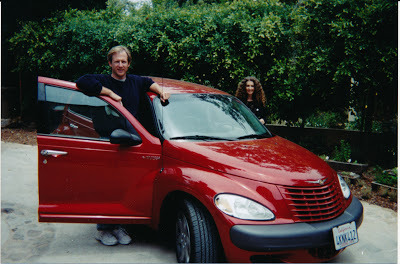
Here is an article I wrote for the LA Times -- in the year 2000! It was part of their “First Person” series, and I wrote it when the PT Cruiser first came out.
To surprise my wife Robin for her birthday I rented a Chrysler PT Cruiser for the weekend -- and in 48 hours we experienced all the thrills and horrors of instant fame.
She drives a fragile '87 Jaguar and wants a new car, so when she saw the Cruiser at the LA Auto Show in January she thought she'd found a car with as much style as her English baby. But when she called dealerships she discovered that no one gives test drives -- because they don't need to. One dealer has 250 cars on order and has delivered only 50 so far -- or so he said over the phone.
Then I found Advantage Car Rental in Van Nuys, where I rented a red PT Cruiser for 90 dollars a day. With full insurance, unlimited mileage and a pre-paid tank of gas, the tag came to $239 for two days. That seemed steep, but it was the same as renting a hot sports car for the weekend -- and right now the PT Cruiser is the cooler car to drive.
"We classify it as a specialty vehicle," explained Andy Gantner, the Advantage area manager, "but we'll probably reevaluate that price as time goes on."
The star of my birthday production drove up front. I was briefly disappointed -- she was smaller in real life than I'd expected from her pictures. But that feeling quickly passed as our first fan appeared before I'd even driven away.
It was the start of a weekend of fan bombardment -- but that's what you get when you hang out in public with a celebrity. Our admirers fell into three categories: polite fans who pretend they aren't looking but sneak glances at you...loud fans who insist on being your friend...and brazen stalkers who say nothing but follow you too closely.
The first guy, a bearded man in his fifties, turned out to be a stalker. He slowly circled me as I transferred dry-cleaning, bags and cassette tapes from my car to the Cruiser. He peered over my shoulder as I lowered the seats in back, then examined the side mirrors as I got behind the wheel. He finally stood right in front of the car and wouldn't move -- even after I'd started the engine. I was afraid to honk.
When I finally tooted the horn he looked me in the eye and just stared. Thankfully he stepped back on the curb and I made my getaway. My first celebrity lesson: don't upset the stalkers.
Robin was thrilled with her birthday gift, once I convinced her I hadn't bought it. She grabbed the keys and after months of waiting finally slid behind the wheel. We hit the town in style. She likes the car because the design reminds her of a London cab or a classic DeSoto. I like it because it reminds me of those same cars souped up into Rat Fink Hot Rods from the 70's.
The interior has the same gray plastic moulding as most standard cars but they've added some flourishes. The speedometer and signals are round and recessed into a retro dashboard coated with red fiberglass that matches the exterior of the car. It's not the metal and wood dashboard of my dreams, but hey, for a mass-produced American car it was good enough.
When you're with a star, errands take longer. It was midday by now and everybody was slowing down to look at us in our hot red car in the bright July sun.
As we walked out of a coffee shop one woman insisted on taking our picture. She took one as we posed by the car, another as we pulled out from the parking space, and another waving at her with the windows down. She walked over.
"You should really meet my son, he loves old cars and would love one of these!" she said, searching through her purse for a pen and paper. The cars behind us started honking and we thankfully had an excuse to drive away.
You can't talk to everybody no matter how nice they are, so soon we were acting like celebrities ourselves. We donned dark sunglasses, just smiled and nodded, and made no sudden movements. Parking lots were tough, but the crowd eventually parted if we moved slowly enough. Robin did mention, however, that it'd be nice if the company provided bodyguards along with the car rental.
We needed a break from all the attention, so Sunday we headed north to Santa Barbara to visit friends for the day. A guy in a convertible Mustang pulled alongside and honked, and he and his blonde girlfriend flashed us the "thumbs up." We waved, all smiles, suddenly accepted by the beautiful people.
But soon it was impossible to change lanes because there was always a car full of rubberneckers alongside checking us out. If we accelerated, so would they. If we slowed down, they'd do the same. Dealing with fans in a parking lot was easy compared to speeding with them down a highway. We missed three exits because we were boxed in by fans cheering us on.
The car was fun to drive, but doesn't have a lot of power -- it gets passed going uphill no matter how cool it looks. It was the most fun at the beach with all the windows down. The hatchback makes it easy to throw junk in the back, and it's small enough to get in and out of any space.
The weekend was a blast, but after 48 hours we were glad to abandon our celebrity status and slip back into the anonymity of our comfortable used cars. When there are thousands of PT Cruisers on the road and the flush of excitement wears off, Robin will go back and try the relationship again. She hopes by then it'll come in British racing green.
Published on June 06, 2013 13:04
May 30, 2013
Travel California: Vitello's Italian Restaurant
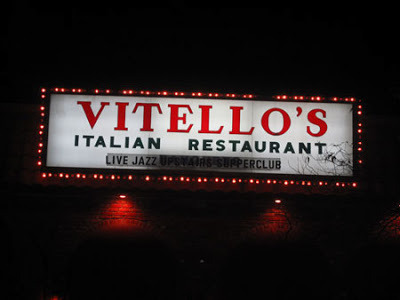
I have a piece of San Fernando Valley history and culture hanging in my garage; it’s a portion of the original mural that graced the main wall in the old Vitello’s restaurant on Tujunga Avenue in Studio City. It’s a painting of the Sicilian fishing village of Cefalu where the former owners, Steve and Joe Restivo were born. They had bought the original restaurant from Sal Vitello in 1977 and had the mural painted, and it stayed there for 35 years. The current owner then bought the restaurant and renovated it by opening up the front wall to the street and making it feel more like a contemporary Italian bistro. But when the wall came down, so did the mural, and the best parts of the mural ended up with me.
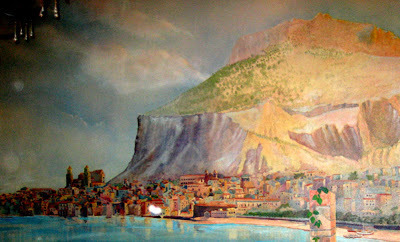 the original mural
the original mural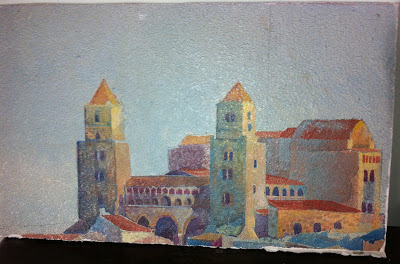 my piece of the mural
my piece of the muralThings must change, and Vitello’s is better for it in my opinion, but the old version of Vitello’s had its charms. It was the classic red Italian restaurant - the booths, the tablecloths, the sauce and the wine were all red, with old school American Italian items on the menu that you only hear being ordered in a movie, like Braciole (pronounced Brazhul), which is meat wrapped in meat.
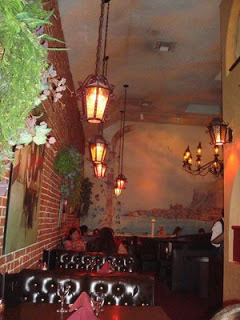
No matter where you are from, there is a version of this Italian restaurant in your hometown. Back in San Francisco where I grew up, it’s Original Joe’s, which had branches throughout the City. When we lived in the Sunset District, the family would head out on Sunday night to Joe’s of Lakeside for spaghetti and meatballs. The San Fernando Valley gets a bad rap for having no culture, but we have plenty going on. However, it’s also true that we tend to celebrate odd vestiges of 1950‘s through 1970‘s American Suburbia as if they were European Renaissance Treasures. Thus, I love my piece of Vitello’s mural, as if it were a portion of Da Vinci’s Last Supper. The old version of Vitello’s also had perfect kitsch. Photos of celebrities graced the interior foyer, like Frankie Muniz and Garry Marshall. In Brooklyn, the same kind of restaurant would have framed and signed photos of Tony Bennett and Frankie Valli.
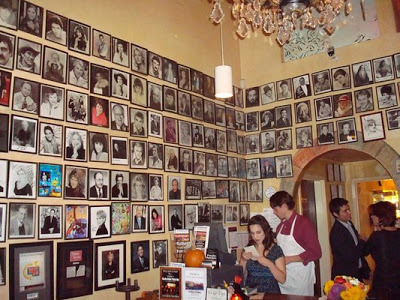
Vitello’s became notorious nationwide in 2001, when Robert Blake’s wife Bonny Lee Bakley was found shot dead a block away from the restaurant after the couple had eaten there. Blake, a regular, had returned to the restaurant because he had forgotten his gun in his usual booth. When he went back out to the car, he says that he found her shot dead, and he was acquitted of her murder. My wife Robin and I loved to go to the old Vitello’s and Steve, the more gregarious of the two brothers, would always come by and say hello and chat. I had read in the press that they despised the notoriety, so it wasn’t until I felt that Steve had accepted me as a regular that I dared to ask him about it. He pointed out which one was Blake’s regular booth and from then on he’d seat us there -- right under an oil painting of an Italian lute player and next to the closet with the vacuum, broom and pungent cleaning supplies, covered up by just a red curtain on a wooden rod. The seat in the booth had come loose so if you sat on the edge it would pop up in back. But the wine was decent, Robin loved the pizzetti, and I liked the fettuccine with artichokes and steak. In 2003, when we thought we were close to starting a family, Robin and I realized we probably wouldn’t get to travel in a big way for many years so we should go have an adventure somewhere. However, it had to be right away. We had both finished shows early and didn’t have our next jobs starting for several weeks, so we had to plan a trip and go on a trip within days -- we just didn’t know where we wanted to go. That night we went to Vitello’s to make plans and Steve overhead us talking and asked us where we were going. “We don’t know, where should we go?” Robin asked. “You should go to Sicily,” Steve said. “Where should we go in Sicily?” Robin asked. “You should go to Cefalu, where my brother and I were born!” said Steve, and pointed at the gigantic mural on the wall behind us. It looked like a make-believe medieval storybook town, on the water below a towering mountain. “Does it really look like that?” I asked. “Of course it does! I’ll give you the name and phone number of my relatives there, you must call them. When are you leaving?” he asked. We followed Steve’s advice. We bought tickets on Thursday and we went to Sicily on Saturday. We were there for two weeks, winging the whole trip, getting lost constantly but eventually driving around the entire island.
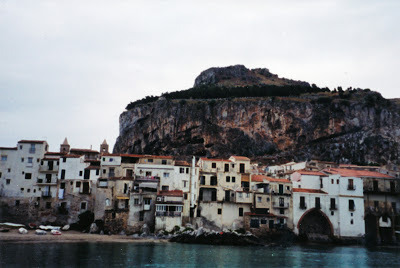 Cefalu
CefaluSicily is on the same latitude as Central and Southern California, so it looks and feels the same in many places. The center of the island has rolling green and yellow hillsides that look like the Salinas Valley, and the coast has towering hills that crash down into the Mediterranean sea, like Big Sur. Many Sicilians came to California too; some childhood friends came back to me when I saw their names on the town signs -- Mazzarino, Randazzo, Trapani. Sicilians are tough people who give you the cold shoulder and a stare down for the first 30 minutes, and then after a meal and a drink they become your best friend and want to spend time with you. We would arrive in a town and pick a restaurant, and then after dinner the owners would insist that we come back and dine with them every night while we were there and that they’d cook special meals just for us. We complied, and the trip was better for it.
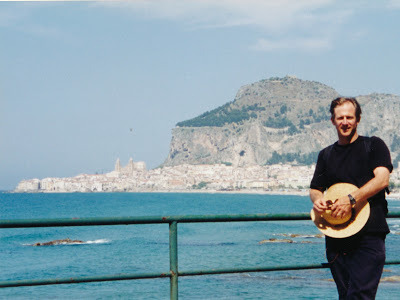
Outside Syracuse we stayed on a farm where we ate dinner with the family, and the paterfamilias leaned across the table and said in broken English, “this American war of yours, it’s a war about oil.” Suddenly nervous, I grabbed the Italian English dictionary and did my best to make conversation, and it worked. Three hours later we were polishing off a bottle of limoncello, and they were refusrf to let us leave the table. Steve was right; Cefalu was the best town (at least for us) and we were stunned that the town looked exactly like the famous mural back in Studio City. The centerpiece of Cefalu is the cathedral. It was built by the invading Normans who came to drive out the Moors, during a time when every town was reinforced to withstand attack by the next conquering army rolling through. Thus the cathedral looks like a castle, which I’m sure it was when the Normans first built it.
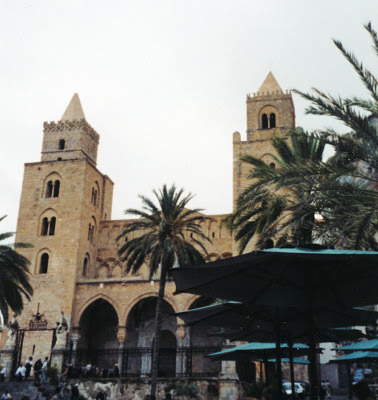
When we returned to Studio City we went to Vitello’s to tell Steve about our trip and he was crushed because we hadn’t eaten dinner with his relatives. We had called once but couldn’t communicate well, we couldn’t reach the right sister, we didn’t think it was crucial, and then we got occupied with our own vacation adventure -- but Steve remained distant. After all, he is Sicilian. It took awhile for him to forgive us, but he did. When the new owner decided to renovate, I begged him for part of the mural and he kindly obliged. The mural is just acrylic paint on drywall so it’s not built to last the centuries, but I got some good pieces,including the section with the Norman cathedral that rises above the town. Each piece is too heavy to frame and too big to hang in the house, so I have them arranged on the walls of the garage. The pieces remind me of the Italian restaurants from my youth, then of Sicily, which reminds me then again of California, and we come again full circle. All I need now is a red booth.
Published on May 30, 2013 13:37
May 23, 2013
California Artist Spotlight : David Trulli
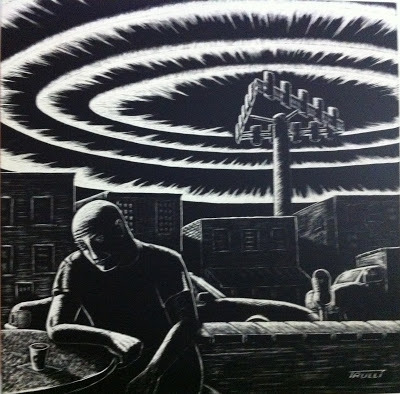
David Trulli is a California artist you should know about. I first met David when I was hired to direct a short documentary about the closing of the Long Beach Naval Shipyard and David was the cinematographer whom the company had hired. We had to create compelling TV out of images of old barracks, rusting ship locks, drained swimming pools, and empty offices. David found a way to shoot the barren mid-Century industrial architecture in a beautiful way, and I found enough characters with great stories to put in those settings that somehow it came to life. I loved his eye, and we stayed in touch. In 2001, I asked him to shoot my short film, Dodgeball,a comedy about a company where to get ahead you must compete in the weekly company dodgeball game. The film pre-dated the feature of the same name, but there’s another story that goes with that. We became friends, and I noticed and admired a few things about him: He is a clothes horse. A lot of Los Angeles cinematographers wear cargo shorts with Hawaiian print shirts, and he said he was tired of being that guy on a set, so he spent some money and graduated up to what he calls “grown-up clothes.” Now he wears suits whenever he works, and he looks good in a fedora. He also inspired me to improve my own wardrobe. He appreciates a good root beer float. When he and his wife Lisa (an amazing editor) came over for dinner in the summer, he enthused about how they are the perfect treat on a hot summer night. David surprised me a few years later when he said he was leaving cinematography to be a fine artist, and that scratchboard was going to be his medium. To me, it seemed daring but risky; much like an actor quitting the theater to become a singer. Yet it worked. He is now a successful fine artist, with his own studio on Hollywood Boulevard, and successful gallery shows every year or show throughout Southern California. In fact, he is part of a show happening right now at the Pacific Design Center featuring black and white art:
Another Year in LAMay 16 - August 9, 2013Pacific Design CenterSuite B2678687 MelroseWest Hollywood, CA 90069323-223-4000
Over the last few years I have bought one original piece, one lithograph from a limited series, and a poster. A good mix, and I can say I collect California art now. His work captures a dark world where there is no escape from modern technology, yet nature and humanity manage to break through, like a blade of grass coming up through the sidewalk. His older work evoked classic Los Angeles Noir, which first drew me to his art, but I like his new pieces even better.
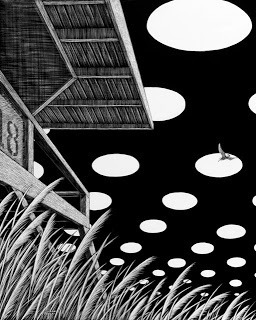 Tranquility Base
Tranquility Base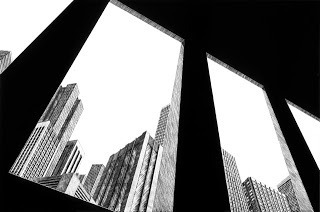 Beyond Daylight
Beyond Daylight 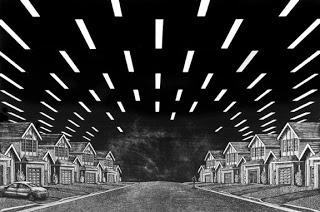 Edge of Town
Edge of TownAlso, as I transition into a new career, I look at David Trulli’s art with an added twist. I think of how he succeeded in becoming someone new, and the idea of self-transformation suddenly seems attainable and not so lofty. He also turned me on to an amazing radio show and podcast, which changed my life and it may change your life as well -- RadioLab, out of WNYC. Whenever we see each other we talk about our favorite RadioLab episodes.
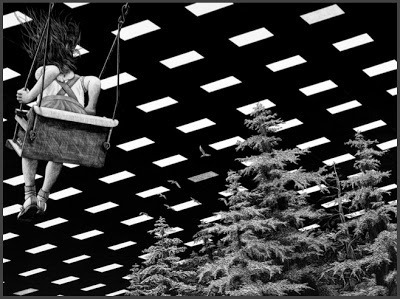 Somewhere Gone
Somewhere GoneCheck out his work at (his current shows listed here):davidtrulli.com
Check out RadioLab at (listen to Sleep and Emergence):radiolab.org
You can find Dodgeball, the film we did together, at:Dodgeball
Published on May 23, 2013 11:48
May 18, 2013
Dark Los Angeles : The Deed
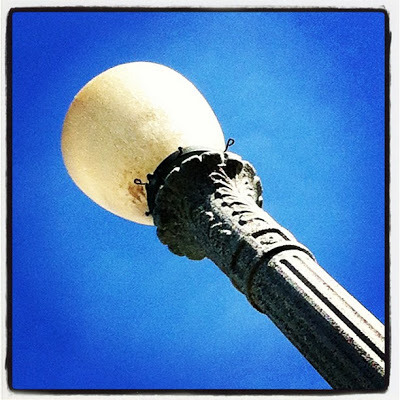
I live in Studio City, which is a neighborhood of Los Angeles, California in the San Fernando Valley. Studio City got its name in 1927 when Mack Sennett built his studio next to a new neighborhood under construction so his studio employees could buy homes and live close to where they worked. That studio became Republic Pictures, where many B-movies and Gene Autry Westerns were shot, and eventually CBS bought the studio and now mostly TV shows are shot there on 18 different sound stages. Early episodes of Leave it To Beaver were shot there, along with most of the Mary Tyler Moore Show. Most residents of Studio City don’t work at CBS Radford Studios, but many work in the Film, TV and Music Industries. There are a lot of old Hollywood touches in the neighborhood. The Sportsmen’s Lodge on Ventura Boulevard has photos in the lobby of the different movie stars who drove out from Hollywood in the 1930s to stay there, ostensibly to hunt, but more often to have affairs. At the end of my block are two wooden buildings built by Universal Studios in the 1940s that look like family homes, but when you look closer they actually hold studio and one-bedroom apartments each with its own private entrance, so young single women under contract could live together without scandal. That’s the sunny side of Studio City, but like every neighborhood in Los Angeles we have a darker side too, often right in front of us. Our home was a tract home built in 1939 and cost $4500 in construction costs. We are the third owners of the property and we have the original deed from 1940. A few pages into the dense legalese, you can find this clause:
i) That no lot in said tract shall at any time be lived upon by an person whose blood is not entirely that of the Caucasian race, and for the purposes of this paragraph, no Japanese, Chinese, Mexican, Hindu, or any person of the Ethiopian, Indian or Mongolian races shall be deemed to be Caucasian; but if persons not of the Caucasian race be kept thereon by such Caucasian occupant, strictly in the capacity of servants or employees of said occupant, such circumstances shall not constitute a violation of this condition.
The Civil Rights Act of 1964 made this clause illegal half a century ago, but it’s still creepy to think that my home and neighborhood were first built to be for whites only. It’s also strange how each race is singled out and described so carefully; you don’t often read Japanese, Chinese, Mexican, Hindu, Ethiopian, Indian and Mongolian people all being excluded by whites in the same sentence. It’s probably a negative reaction to a positive California trait - California has always attracted immigrants from around the world, and in 1939 there were probably enough Japanese, Chinese, Mexican, Hindu, Ethiopian, Indians and Mongolians living here to strike fear into home developers trying to keep their new California neighborhoods lily-white. I don’t think tract home developers in Alabama or Texas in 1939 put the same clause into their title documents; if anything, I suspect that those states would have excluded groups of people with the all-inclusive words “colored” and maybe “Jewish.” I also wonder what groups of people they were trying to exclude by writing “Ethiopian” and “Mongolian.” You don’t meet Ethiopians and Mongolians very often in the United States, so in their ignorance they must have been mislabeling some group of people -- maybe Native Americans? Studio City is still predominately white. There are Asian and Hispanic residents, but Caucasian is still the majority. I wonder how that will change over the next few decades as California and the United States continues to change. Keep reading the blog for more dark facts about sun-splashed Los Angeles.
Published on May 18, 2013 13:41
May 15, 2013
Australia : Body Surfing
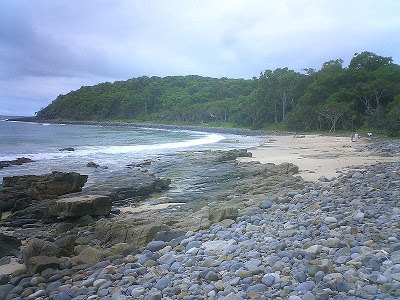
The only time I came close to dying while swimming was in Australia. That seems appropriate -- the vast country is still wild and untamed and people are used to living with a certain degree of danger. There are birds in downtown Sydney that attack you when you approach their nests and nobody thinks twice about them. There are sharks in Sydney harbor, and the Australians string long nets along all the eastern beaches to keep the hungry predators out. Further north, box jellyfish near shore can kill you with one sting, and children wear full-length lycra swimsuits for protection both from the tentacles and from the blazing sun. You can’t drive too fast at night in the outback, because you’ll hit a kangaroo or a wombat and destroy your car. And along the marshes and beaches there are saltwater crocodiles that crawl into campsites and chew up drunken clods who falls asleep in the sand. But the risk is part of the fun, and downplaying the danger is part of the cultural identity. Sure you can get hurt -- you’re in Australia. It happened to me on the Sunshine Coast at Noosa Head, which is a large peninsula with a hundred acres of remaining rainforest that juts out from the perfect straight coastline. There are hotels on the beach to the north and condos and private homes on the hundred kilometer beach to the south, but right at Noose Head you can walk into the rainforest and in less than an hour find a completely isolated and unsheltered wild beach. Coves and points are good for swimming and surfing for a reason. Swells come in from the ocean and their energy gets funneled over the reefs and rocks and focused into regular steady waves that pass the point and leave the cove sheltered. Nature becomes orderly. But if the beach has no reef, no sandbar, no point or cove to focus the energy, then all the power of the ocean hits the beach head-on. It’s chaos. The waves seem small and predictable, and then become huge. Sandbars build up in sections on the beach, and then a week later are gone. Because the water energy coming in makes little sense, the water going out makes even less sense, so there are strange currents and undertows that pop up and disappear. I walk through the rainforest and find my beach -- a mile long stretch of sand that faces the full force of the Pacific. I’m the only person there. That happens a lot in Australia. Getting off by yourself is not a hard thing to do on a continent with only twenty million people, most of them in cities. Signs are posted that there is no lifeguard on duty. The water is rough, so I go in with flippers to help me power under the waves. I’m breaking one of my own rules -- no one is there to see me and none of my friends even know I’m out here doing this. But I just hiked all this way and I want to get wet. I rely on my standard procedure. I dive under the first line of breakers and about seventy-five yards out I turn and swim parallel to the beach. Further out there are even bigger waves, and I’m swimming in the hundred yard clear area between where they first break out at sea and then reform again into new waves that crash onto the beach. After five minutes of easy swimming, a wave approaches and instead of breaking it keeps getting bigger. I swim out to meet it, sprinting up its face before its tower of water topples over and crashes on me. I'm ten feet high at the top and then it breaks just past me, sending up mist, and I feel the tail end of the wave pull at my fins like a hand that just missed grabbing me. I see another one coming that’s not as big and I decide to ride it, turning sideways and kicking hard with my fins until I feel its power catch me. I scream down the face and try to tuck back into the wave at the last moment but the wall is too thick and I can’t break through. A wave is like a moving barrel full of water that must keep turning to empty itself, and now I'm stuck inside. The barrel rolls me off the bottom, up the backside, over the top, and flings me down against the bottom, knocking the wind out of me and driving my shoulder and cheek into the sand, and still it keeps emptying more and more water onto my back, making it impossible to move. Then suddenly the barrel is empty, all the force is gone and there’s no resistance at all, just foam. I flail with my arms in a mixture of water and air with no sense of up or down. I find the surface and fight to fill my lungs, then gasp air and head out to sea, rushing to get under or over the next wave before it catches me and tosses me into another rinse cycle. I make it past the next wave but when I pop up there’s another one right behind it. The clear area between the outside waves and inside waves has disappeared; it’s all huge waves now, crashing, reforming, and then crashing again. Going in won't work, so I head out as fast as I can, kicking madly up some waves, diving deep under others. Four hundred yards out I finally find blue water again. The swells moving under me are enormous, and I must keep kicking to stay in one place and not get pulled back in. At the peak of each swell I can see the entire mile long stretch of beach -- but between it and me is all white crashing chaos. Going back in right now would be suicide. I’m so happy I have fins on. I'd packed them at the last moment, not sure I wanted to ruin the purity of my swim by wearing them and now I know they saved my life. But I'm not safe yet. I could swim a mile around the point and try to find a way into land that way, but I’m exhausted and this set of waves might be just as bad over there, so I wait until my strength returns. After forty minutes of bobbing and treading water the waves shrink back to a size I can manage and I swim into shore on the backside of waves, spinning my arms as fast I can before the next one forms. I limp back up the beach and I'm amazed that my towel is still in the exact spot where I'd left it, as if I've been gone for a year instead of an hour. I notice for the first time that it's bright blue; in fact, everything around me is clear and vivid. I feel changed, but no one is present to witness what I went through. I collapse on my towel and rest for a full hour without moving. The sun sets and I have to hike back through the rainforest on a pitch black trail, but by now I’m afraid of nothing. I emerge into brightly-lit Noosa, and I rejoin the crowd. I also swear I’ll never swim alone in again in place I’ve never been before.
Published on May 15, 2013 11:52

